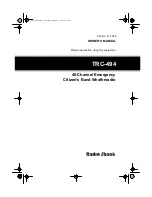
4.6
Alert Tones
Your radio uses alert tones to inform you of the condition of your radio. The following table lists these
tones and when they occur.
You Hear
Tone Name
Heard
Short, Low-
Pitched
Tone
Radio Self Test Fail
When radio fails its power-up self test.
Reject
When an unauthorized request is made.
Time-Out Timer Warn-
ing
Four seconds before time out.
No ACK Received
When radio fails to receive an acknowledgment.
Long, Low-
Pitched
Tone
Time-Out Timer Timed
Out
After time out.
Talk Prohibit/PTT In-
hibit
(When
PTT
button is pressed) transmissions are not al-
lowed.
Lack of Voice PTT
Time out
When the radio ends your call after it detected there
are lack of voice for five seconds after the PTT is
pressed and hold. Your radio ends the call to enable
your radio to receive calls from other radio users.
Invalid Mode
When radio is on an unpreprogrammed channel.
A Group of
Low-Pitch-
ed Tones
Busy
When system is busy.
Short, Me-
dium-Pitch-
ed Tone
Valid Key-Press
When a correct key is pressed.
Radio Self Test Pass
When radio passes its power-up self test.
Clear Voice
At beginning of a non-coded communication.
Priority Channel Re-
ceived
When activity on a priority channel is received.
Emergency Alarm/Call
Entry
When entering the emergency state.
Central Echo
When central controller has received a request from a
radio.
Long, Medi-
um-Pitched
Tone
Volume Set
When volume is changed on a quiet channel.
Emergency Exit
When exiting the emergency state.
A Group of
Medium-
Pitched
Tones
Automatic Call Back
When voice channel is available from previous request.
Console Acknowledge
When status or emergency alarm ACK is received.
Received Individual
Call
When Call Alert is received.
Call Alert Sent
When Call Alert is received by the target radio.
Short, High-
Pitched
Tone
(Chirp)
Low-Battery Chirp
When battery is below preset threshold value.
MN003602A01-AF
Status Indicators
31
















































